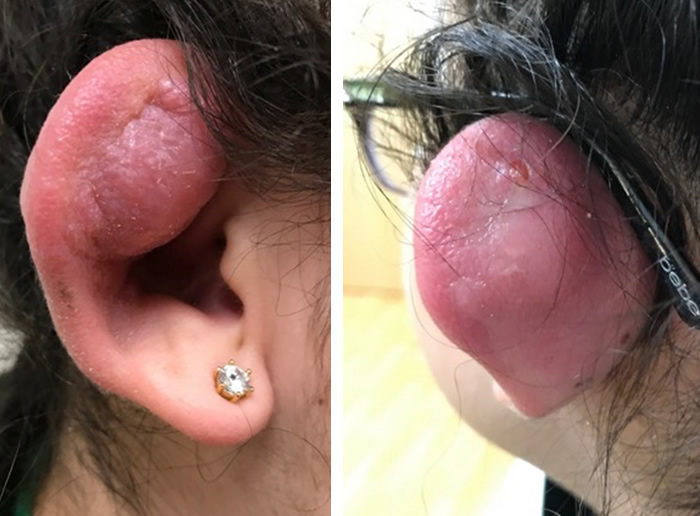If Not Otitis Externa, Then What?
Flasch E, Ansari S
Children's Wisconsin, Milwaukee, WI, USA
A 16-year-old female presents with ear pain and swelling for the last 10 days. Cartilage pierced 17 days ago. Seen at another hospital 10 days prior with erythema and purulent drainage from the piercing site. Started on Augmentin 875-125 mg BID Seen again at same hospital, six days prior to the visit with worsening symptoms. She was referred to a general surgeon’s clinic. There, incision and drainage (I&D) done and recommended to continue Augmentin. She continued to have worsening swelling, erythema, and purulent thick drainage and thus presented to Children's Wisconsin Urgent Care (UC).
- Physical exam: Heart rate 64, respiratory rate 16, temperature 36.8°C
- General: mild distress, tearful due to pain
- Ear: (See image) On palpation, moderate to severe tenderness with fluctuance

Digital images taken via Haiku into EPIC. ENT phone consult done during UC visit. ENT recommended admission. Once admitted, she was started on IV ciprofloxacin (400 mg BID) with plans for I&D in the operating room. After successful I&D and short hospital stay (72 hours), she was discharged with diagnosis of perichondritis/abscess and given 10 days of oral ciprofloxacin (500 mg BID). An aerobic and anaerobic culture was sent and grew few Pseudomonas Aeruginosa which was susceptible to Ciprofloxacin. She followed up in ENT clinic 2 weeks later. During the visit, her ear was noted to be healing well. Three months after UC visit, the ear was healed with a residual defect in the cartilage.
Auricular abscess/perichondritis from helical ear piercing is a frightening complication that can lead to residual deformities. Helical piercings are associated with poor healing and more serious infection due to the avascular nature of auricular cartilage. Piercings are usually carried out by untrained professionals with no consensus on aseptic techniques.
The most common pathogen is Pseudomonas Aeroginosa followed by Staphylococcus Aureus. Symptoms develop 3 days to 4 weeks after the ear piercing and include: pain, erythema, edema, and drainage. Diagnosis is made clinically and wound culture must be performed. Fluoroquinolones are the treatment of choice due to dual anti-pseudomonal and anti-staphlyococcal activity. Once an abscess develops, surgical I&D is often necessary. Good cosmetic preservation of the cartilage is difficult to maintain.
- Keene WE et all (2004). Outbreak of Pseudomonas aeruginosa infections caused by commercial piercing of upper ear cartilage. JAMA. 291:981-985
- Mitchell, S. et al (2014). Pinna Abscesses: Can we manage them better? A case series and review of the literature. European archives of Oto-rhino-laryngology. 272, (11), 3163-3167
JOIN OR RENEW WITH SPUC TODAY!
PLAN NOW!

SPUC's 7th Annual Conference
Brought to the learner in virtual format
_____________
Committee Opportunities
Want to make a difference in our developing specialty of Urgent Care Pediatrics?
Join a SPUC Committee or workgroup!
 Winter 2021
Winter 2021

